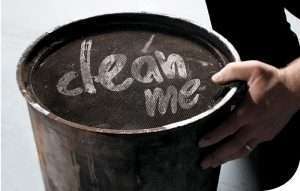
Diesel Particulate Filters (DPFs) play a vital role in reducing harmful emissions from diesel engines, capturing soot particles and preventing them from being released into the environment. Over time, DPFs accumulate soot and undergo regeneration processes to burn it off. However, this continuous cycle leaves behind a residue called ash, which can eventually lead to the need for industrial cleaning. In this article, we will delve into the frequency of DPF cleaning, the limitations of chemical or on-car cleans, and provide some general guidelines for maintaining clean filters.
DPF Regeneration and the Build-Up of Ash
DPF regeneration is an essential process that helps clear accumulated soot from the filter. During regeneration, high exhaust temperatures burn the soot into a gas that can pass through the porous filter walls, and out the exhaust tail pipe. However much like burning wood in a campfire, there is always a bit of ash leftover at the end. In the case of DPF regeneration, this residual ash cannot be completely eliminated through regular regeneration alone. It gradually accumulates within the filter, necessitating eventual industrial cleaning to maintain optimal performance.
The Need for DPF Cleaning
While chemical or on-car cleans can temporarily clear blockages and facilitate normal regeneration, they are not a long-term solution for filters with higher mileage. These DPF cleaning methods do not remove the ash from the filter, which can lead to reduced performance and potentially more severe blockages. Industrial cleaning is the most effective method for completely removing the ash and restoring the DPF’s functionality.
What is Industrial DPF Cleaning?
Industrial cleaning is a comprehensive process specifically designed to remove accumulated soot and ash from the Diesel Particulate Filter (DPF). This procedure, carried out at specialized facilities, involves skilled technicians using techniques like pneumatic cleaning systems. These systems utilize compressed air to create high-pressure pulses that dislodge and push the ash back out through the filter cells. By pushing the ash out the way it entered, the DPF’s capacity to effectively capture and remove soot particles is restored. Other methods, such as ultrasonic cleaning baths or specialized cleaning agents, may also be employed to ensure a thorough cleaning. It’s important to note that industrial cleaning should be performed by trained professionals to avoid potential damage and ensure optimal results. By undergoing regular industrial cleaning, DPFs can maintain longevity, efficiency, and compliance with emissions regulations, thus minimizing engine-related issues.
Factors Influencing Cleaning Frequency
There is no definitive rule of thumb regarding how often a DPF cleaning is required. The cleaning interval depends on various factors such as engine size, physical filter size, and even the type of engine oil used upstream. However, we can provide some rough guidelines based on experience and industry recommendations.
Light Vehicles and Commercials: For these types of vehicles, it is generally recommended to have the DPF cleaned every 150,000 kilometers. This interval allows for regular maintenance and ensures optimal performance and longevity of the filter.
Heavy Vehicles: Due to the higher demands and greater emissions of heavy vehicles, the filter is generally a lot larger than that on a light vehicle. It is advisable to clean the DPF approximately every 300,000 kilometers. This extended interval accounts for the additional strain placed on the filter and ensures efficient operation over a more extended period.
Off-Road Plant & Equipment: For off-road machinery and equipment, such as construction vehicles, it is recommended to clean the DPF every 2,000 hours. These applications typically involve harsher operating conditions and increased soot accumulation, necessitating more frequent cleaning.
Conclusion
DPF cleaning is crucial for preserving engine performance, complying with emission regulations, and minimizing environmental impact. While DPF regeneration effectively burns off soot particles, the ash residue requires periodic industrial cleaning to prevent clogging and ensure optimal operation. Chemical or on-car cleans may offer temporary relief but do not address the ash buildup, making them less suitable for long-term use, especially in higher mileage filters. By following recommended cleaning intervals, vehicle owners can maintain clean DPFs, prolong the life of their filters, and contribute to cleaner air for all.
Remember, regular maintenance and cleaning are essential for your DPF’s health and the overall well-being of your diesel engine.


